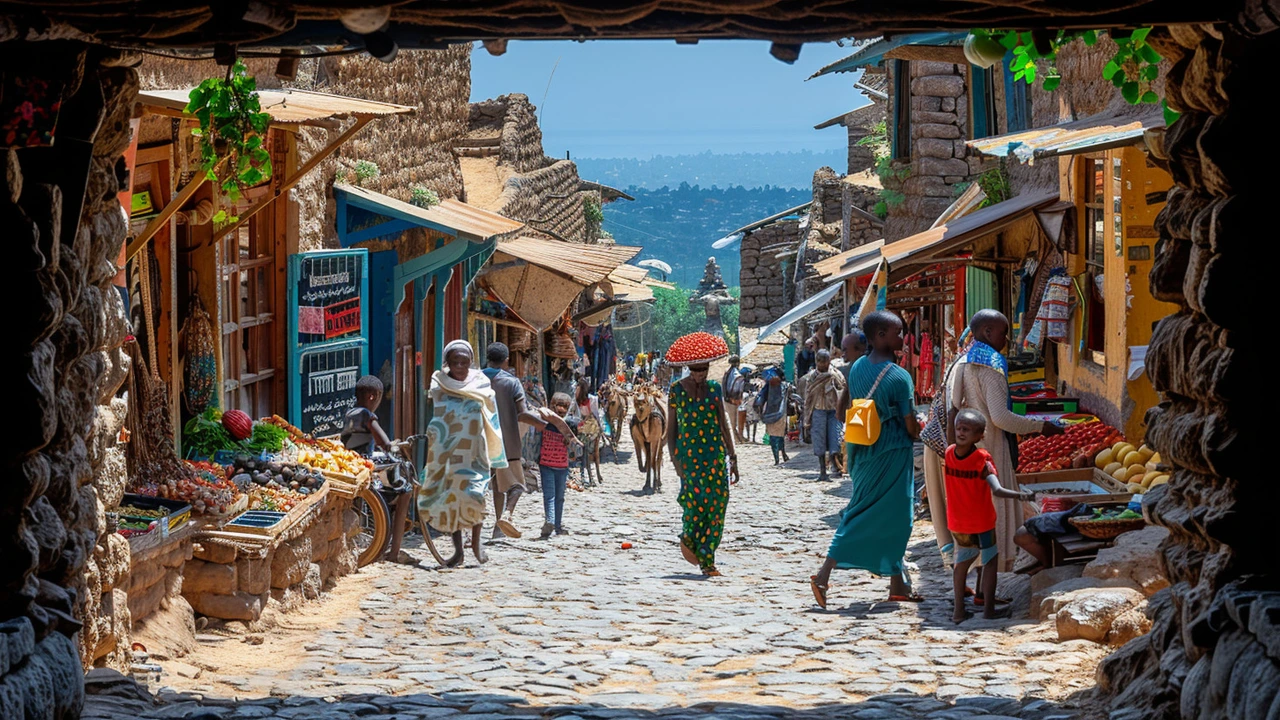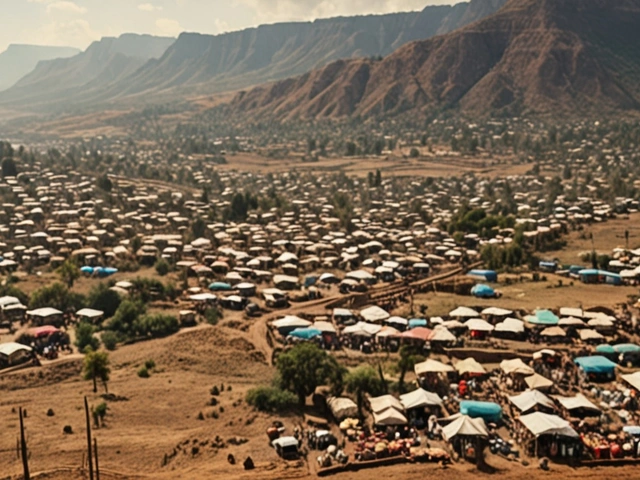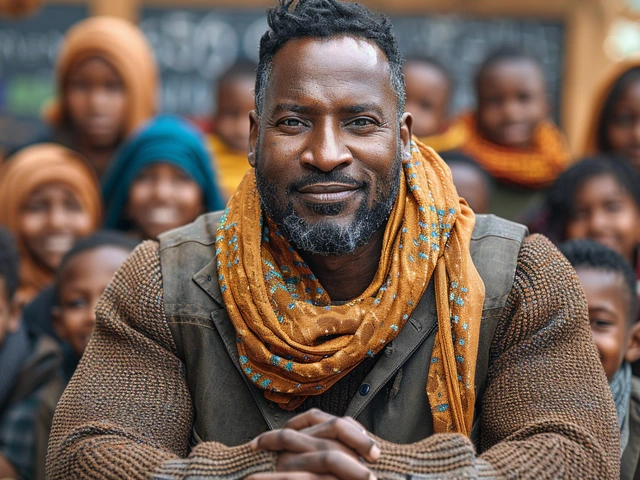When it comes to identifying the poorest city in Ethiopia, several factors come into play, painting a detailed picture of a place battling economic and social difficulties. This exploration shines a light on the depth of hardship faced by the people living here, while also highlighting their resilience and hope.
Understanding the dire poverty in this city helps in grasping the complexity of its challenges. From chronic unemployment to a lack of essential services, every aspect contributes to a cycle that is tough to break. It’s a reality where survival often takes precedence over any long-term planning.
Understanding Dire Poverty
Understanding the poverty situation in Ethiopia's poorest city requires an in-depth look at various interconnected factors. Poverty here is not merely about low income; it's a complex web of economic, social, and environmental challenges. The residents often find themselves stuck in a cycle where accessing basic needs like food, shelter, and healthcare is a daily struggle. Lack of infrastructure means that even essential services like clean water and electricity are scarce.
Unemployment is rampant, with a high percentage of the population unable to find stable jobs. This is compounded by a lack of educational opportunities, leaving many without the skills required for the few available jobs. This creates a scenario where even young adults, who should be full of potential, see little hope for improvement in their circumstances. Moreover, the agricultural sector, which many depend on, is heavily affected by unpredictable weather patterns, making it a precarious source of livelihood.
A report by the World Bank highlighted that nearly 30% of households in some of the poorest areas live below the national poverty line. This stark statistic points to the extensive reach of poverty in this city. Add to that the limited access to healthcare, and you find a population grappling with preventable diseases simply because they can't afford medical care or live too far from the nearest clinic. Malnutrition is a common issue among children, stunting their growth and limiting their future possibilities.
Compounding these issues is the rate of urbanization, which often outpaces infrastructure development. Slums emerge as impromptu solutions to housing problems, where families live in cramped, unhygienic conditions. These informal settlements lack proper sanitation facilities, exacerbating the already dire health challenges. Many children growing up in these areas miss out on education because they have to work to support their families or because the schools are overcrowded and under-resourced.
Despite these challenges, there's an incredible resilience among the people. Community solidarity is a lifeline, wherein neighbors help each other with whatever little they have. Small, informal businesses and markets spring up, illustrating the entrepreneurial spirit that refuses to be dampened by hardship.
"In times of need, communities pull together. It's this brotherhood that keeps us going," says Meron Tadesse, a local community leader.
Efforts to improve the situation are ongoing, with various non-profit organizations and governmental initiatives focusing on creating sustainable change. For instance, programs aiming to improve agricultural techniques are underway, providing farmers with better tools and education to combat weather-related challenges. Education initiatives are also crucial, as they empower the younger generation with the skills needed to break out of the poverty cycle.
Economic Challenges
One of the most daunting aspects of poverty in Ethiopia’s poorest city is its economic challenges. These challenges manifest in several ways that are deeply interconnected. Chronic unemployment is a major issue, with many residents struggling to find stable employment. The scarcity of jobs is exacerbated by a lack of industries and businesses willing to invest in the area. Without economic activity, opportunities for growth remain sparse, causing a vicious cycle of poverty to continue uninterrupted.
Another significant factor is the poor state of infrastructure. Roads in and out of the city are often in disrepair, making it difficult for goods and services to flow smoothly. This isolation prevents market access, limiting trade and restricting economic development. Connectivity, both physical and technological, is vital for progress, and its absence is keenly felt.
The city's limited access to education compounds these economic challenges. Schools are often underfunded and lack essential resources, which impacts the quality of education that children receive. This, in turn, affects their future employment prospects, with many unable to break out of the cycle of poverty. Education is a cornerstone for economic mobility, and without it, the city's residents find it hard to envision a brighter future.
Furthermore, healthcare services are inadequate, causing a rise in health issues that affect the workforce. Many households cannot afford basic healthcare, leading to untreated illnesses that further impede the ability to work. When people are unhealthy, their productivity drops, creating another barrier to economic development. It’s a daunting scenario where poor health directly reduces economic output.
Agriculture, which is supposed to be a backbone for many, faces its challenges too. Smallholder farms dominate the landscape, but they are highly susceptible to climate change. Droughts and floods can destroy crops, leaving families without income. This uncertainty in agriculture keeps farmers in a state of perpetual risk, making it difficult to save money or invest in better farming techniques. The reliance on old farming methods also limits productivity, keeping yields low.
On a social level, the lack of financial institutions, such as banks and credit facilities, means that residents have little access to credit or savings opportunities. Without financial services, starting a business or expanding an existing one is virtually impossible for most. The informal economy may thrive, but it doesn’t provide a stable foundation for economic growth. Financial inclusion is a crucial step towards creating economic opportunities, but it's severely lacking here.
Despite these challenges, there are glimpses of hope. Some non-governmental organizations (NGOs) and local groups are working tirelessly to implement sustainable projects aimed at reducing poverty and stimulating growth. From improving agricultural techniques to setting up small businesses, these initiatives are planting seeds of change. A man known for his grassroots work in these areas once said,
“The key to overcoming poverty is not just in financial aid, but in building capacities and empowering people to take charge of their own future.”These words resonate with the idea that long-term solutions must focus on empowerment and resilience.
In summary, tackling the economic challenges in Ethiopia's poorest city requires a multi-faceted approach. Addressing unemployment, improving infrastructure, ensuring education and healthcare access, and enhancing agricultural productivity are all crucial. Only through deliberate, sustained efforts can there be a real chance to turn the tide on poverty and create a more prosperous future for its residents.
Impact on Daily Life
Living in Ethiopia's poorest city means facing immense daily challenges that significantly impact one's way of life. The most glaring issue is the lack of access to basic necessities such as clean water, adequate food, and healthcare. For many families, securing these essentials requires long treks on foot, often for miles, just to fetch water or to receive basic medical attention. The scarcity of these basic needs is a huge burden on the daily lives of the residents.
Education is another significant challenge. In many areas of the poorest city, school attendance is low because children are often required to help support their households. Even when children can attend school, the quality of education is subpar due to a shortage of resources, unqualified teachers, and poor infrastructure. Classes are often held in dilapidated buildings with few books and supplies, making it difficult for students to succeed academically.
Jobs are scarce and the local economy is heavily dependent on agriculture, which is vulnerable to droughts and other climate-related issues. This vulnerability makes reliable employment hard to come by. When work is available, it is often underpaid and labor-intensive, leaving many workers struggling to make ends meet. This lack of economic opportunities perpetuates a cycle of poverty that is tough to escape.
The healthcare situation is dire as well. Medical facilities are often underfunded and ill-equipped to handle the needs of the population. Simple medical procedures and treatments can become life-threatening due to the lack of proper medical care. Maternal and child mortality rates are high because of complications that could easily be treated in better-equipped facilities. These healthcare challenges have a profound effect on the population's wellbeing and lifespan.
Beyond these tangible challenges, the psychological impact of living in perpetual poverty is enormous. The constant struggle to survive can lead to mental health issues such as depression and anxiety. community. Despite these hardships, the people of Ethiopia's poorest city display an incredible resilience. They rely on tight-knit community bonds, mutual aid, and hope for a brighter future as they navigate their difficult daily lives.
It's essential to recognize that while aid and development projects strive to alleviate these conditions, more sustainable solutions are necessary to uplift the population out of poverty. As awareness grows about the specific challenges faced by the residents, more targeted and effective actions can be taken to support them. Understanding their daily experiences is the first step in this crucial endeavor.
Steps Towards Improvement
Breaking the cycle of poverty in Ethiopia's poorest city requires multifaceted approaches, most of which start with an emphasis on education and skill development. Ensuring that young people have access to quality education lays a strong foundation for future opportunities. Vocational training programs can equip adults with skills that are in demand in the local job market, opening pathways out of poverty.
Healthcare access is another crucial step. Without adequate medical facilities and services, communities struggle with preventable diseases, which in turn hampers their ability to work and contribute economically. Improving healthcare infrastructure in these areas, along with campaigns focused on preventive care and education about hygiene, can bring about substantial change.
A common thread in most of these efforts is community engagement. When local people are involved in planning and decision-making, the solutions are more suited to their specific needs. Microfinance initiatives have shown promise, providing small loans to individuals to start businesses and create $jobs$. This approach has particularly benefited $women$, who are often primary caregivers and breadwinners in many households.
"It's about creating an ecosystem where people support each other and grow together," says Dr. Abebe, a development expert focused on rural Ethiopia. "The success stories we see always involve strong community ties and collective action."
Agricultural development plays a vital role as well. Many of the poorest areas are rural and depend heavily on farming. Introducing sustainable farming practices, improving access to markets, and providing resources like seeds and tools can boost productivity and income levels. This coupled with infrastructure improvements like better roads and transportation can make a significant difference.
One ambitious project aimed at addressing these issues is the Growth and Transformation Plan (GTP), spearheaded by the government. This initiative encompasses multiple sectors, including education, healthcare, agriculture, and infrastructure, aiming for an integrated approach to alleviate poverty. With dedicated follow-through, it promises long-term improvements.
Partnerships with international organizations and NGOs also pave the way for progress. These collaborations bring in much-needed funds, expertise, and resources. For example, water projects funded by international donors have tackled the critical issue of access to clean water, reducing the burden on communities and improving overall health.
Ultimately, sustainable development in Ethiopia's poorest city hinges on comprehensive strategies that address both immediate needs and long-term goals. The key lies in a holistic approach that combines education, healthcare, economic opportunities, and community involvement, creating a framework for lasting change.

 Challenges and Realities of Living in Ethiopia: Overcoming Daily Hurdles
Challenges and Realities of Living in Ethiopia: Overcoming Daily Hurdles
 Is Ethiopia a Wealthy Nation or Struggling with Poverty?
Is Ethiopia a Wealthy Nation or Struggling with Poverty?
 Can Foreigners Purchase Real Estate in Ethiopia?
Can Foreigners Purchase Real Estate in Ethiopia?
 Why Ethiopia is Thriving: Unveiling the Secrets Behind Its Success
Why Ethiopia is Thriving: Unveiling the Secrets Behind Its Success
 English Teacher Salaries in Ethiopia: How Much Can You Earn?
English Teacher Salaries in Ethiopia: How Much Can You Earn?
Abhijit Pimpale
May 17, 2024 AT 18:13The chronic unemployment metric alone eclipses other indicators.
christine mae cotejo
May 17, 2024 AT 18:56When I first read about the depths of hardship in this Ethiopian city, my heart clenched with a sorrow so palpable it seemed to echo through the very paragraphs.
Every statistic you present is a stark reminder that beneath the numbers lie human lives frayed by endless struggle.
The sheer scale of malnutrition among children reads like a tragic chorus, each syllable a testament to futures denied.
Yet, amidst this bleak tableau, the resilience of the community shines with an almost cinematic brilliance, as if the human spirit refuses to be extinguished.
Families band together, sharing scarce water like treasured gold, while informal markets buzz with a ferocious tenacity that defies the surrounding desolation.
These grassroots enterprises, though modest, are the lifeblood that keeps hope pulsing in the veins of the city.
Infrastructure decay, especially the crumbling roads, forms a vicious barrier, choking trade and isolating the populace from essential services.
Without reliable transport, even the most well‑intentioned aid programs falter, leaving aid to evaporate like mist before reaching those in need.
The educational deficit, stark and unforgiving, cuts off a generation from the keys to upward mobility, perpetuating the poverty loop with relentless precision.
Schools, where they exist, crumble under overcrowding, while teachers grapple with insufficient resources, turning learning into a daily battle.
Healthcare, too, tumbles into disarray; preventable diseases claim lives simply because clinics are too distant or under‑equipped to intervene.
Maternal mortality spikes, not from lack of will, but from the heartbreaking absence of timely medical attention.
Climate volatility adds another brutal layer, as erratic rains and droughts strip farmers of stability, leaving fields barren and wallets empty.
Yet, within this storm of adversity, community leaders like Meron Tadesse emerge as beacons, their words stitching together a fragile tapestry of solidarity.
In the face of such overwhelming odds, the city’s unfaltering determination is the most potent antidote to despair.
It is this unyielding spirit that must be the foundation upon which sustainable development programs are built, for without people’s intrinsic drive, even the grandest plans crumble.
Douglas Gnesda
May 17, 2024 AT 19:46From a development economics perspective, the interplay between infrastructure deficits and market access creates a classic case of spatial disequilibrium, where the lack of viable transport corridors inflates transaction costs and suppresses agri‑value chains.
The dearth of financial intermediation further compounds this issue, as micro‑credit scarcity limits capital formation for SMEs, curbing entrepreneurial scaling potential.
Moreover, the human capital gap-exemplified by underfunded schools and limited vocational training-diminishes labor productivity, reinforcing a low‑skill, low‑wage equilibrium.
Policy interventions should therefore adopt a multimodal approach: prioritizing road rehabilitation to reduce logistics friction, while simultaneously deploying mobile banking units to foster financial inclusion.
In parallel, leveraging public‑private partnership models can catalyze investment in renewable energy micro‑grids, addressing the chronic electricity deficit that hampers both domestic life and small‑scale manufacturing.
These synergistic strategies, when coupled with community‑led monitoring frameworks, can create feedback loops that iteratively refine program effectiveness.
Eric DE FONDAUMIERE
May 17, 2024 AT 20:36Great point! I think the micro‑finance pipeline can definitely boost economic elasticity-let's push it! This energry can inspirte te community to take action.
Pauline Herrin
May 17, 2024 AT 21:26The article, while comprehensive, suffers from a lack of critical analysis regarding the efficacy of the cited interventions; the author appears to accept program outcomes at face value without interrogating the underlying cost‑benefit ratios.
Furthermore, the narrative neglects to address potential unintended consequences, such as market distortion from subsidized inputs or dependency on external aid streams.
A more rigorous examination of longitudinal impact studies would strengthen the argument and provide readers with a nuanced understanding of sustainable development pathways.
Horace Wormely
May 17, 2024 AT 22:16The critique raised in the preceding comment is valid; however, the article does include several empirical references that substantiate its claims, and it acknowledges program limitations in the concluding section.